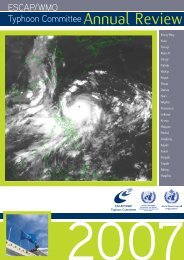TCAR - Typhoon Committee
TCAR - Typhoon Committee
TCAR - Typhoon Committee
Create successful ePaper yourself
Turn your PDF publications into a flip-book with our unique Google optimized e-Paper software.
30<br />
ESCAP/WMO<br />
<strong>Typhoon</strong> <strong>Committee</strong> Annual Review 2009<br />
southern China at 21:10, August 6 2009 and at 7:46<br />
on August 10 2009. The mobile radar observation<br />
was made at Sports Centre in Ningde City of Fujian<br />
Province (119.3295° E, 26.3975° N). A variety of<br />
weather information about typhoon “Morakot” (August<br />
6-10) and the atmospheric boundary layer before<br />
and after landing were obtained, including GPS data<br />
observed about every 3 hours, as long as 80 hours<br />
or more consecutive wind profiler radar, ultrasonic<br />
anemometer-thermometer system, automatic<br />
weather stations, laser raindrop spectrometer, as well<br />
as multi-channel microwave radiometer observations.<br />
b. Hydrological Achievements/Results - Ministry of<br />
Water Resources (MWR)<br />
To improve capacity of hydrological service,<br />
the Hydrological Bureau, MWR upgraded its<br />
comprehensive operational hydrological systems<br />
across the country and organized Phase 2 project<br />
for establishing a National Flood Control and<br />
Drought Relief Database. Breaking events monitoring<br />
display and teleconference functions were added<br />
to address urgent water-related public events.<br />
The function of flash flood warning and feedback<br />
module was improved to achieve automatic retrieval<br />
of warning information and automatic feedbacks.<br />
GIS functionality was upgraded and improved to<br />
enhance inquiry efficiency in flood control. Rainfall<br />
distribution mapping system suitable for PDA devices<br />
was developed, which provides new functions for<br />
accessing rainfall.. Warning information access was<br />
also enabled, while existing geographic information<br />
and data were improved.<br />
Moreover, the Hydrological Bureau organized and<br />
held workshops and seminars on hydrological<br />
information prediction at different levels and for<br />
different practitioners aimed at enhancing local<br />
hydrological service capabilities. For example,<br />
Hydrological Prediction Training Course for Tibetans<br />
was held in September 2009 in Linzhi, Tibet AR. Over<br />
30 local hydrological staff attended it. In October, a<br />
National Hydrological Information Prediction Capacity<br />
Workshop was held in Xining, Qinghai Province, and<br />
representatives from hydrological establishments<br />
in 31 provinces, river basin authorities and Xinjiang<br />
Production and Construction Corps attended it.<br />
c. Disaster Prevention and Preparedness<br />
Achievements/Results<br />
N/A<br />
d. Research, Training, and Other Achievements/<br />
Results<br />
Research progress on typhoon mechanisms<br />
Unusual Variation of Landing Tropical Cyclone<br />
Behavior and Associated Physical Mechanism - A<br />
National Basic Research Program of China (2009 -<br />
2013)<br />
A 5-year project entitled “Unusual Variation of<br />
Landing Tropical Cyclone Behavior and Associated<br />
Physical Mechanism” is funded by the Chinese<br />
National Basic Research Program in2009, aiming<br />
to improve the forecast ability of landing TCs by<br />
studying the mechanism of unusual change of<br />
landing TC behaviors, including track, intensity,<br />
high wind and heavy precipitation. Leading institute<br />
of the project is Shanghai <strong>Typhoon</strong> Institute/<br />
CMA in collaboration with the Chinese Academy of<br />
Meteorological Sciences, National Meteorological<br />
Centre, Institute of Tropical and Marine Meteorology<br />
under CMA, Institute of Atmospheric Physics/CAS,<br />
Nanjing University, Beijing University and Nanjing<br />
Information Science and Technology University.<br />
The main goals are to: (1) reveal the ocean-landatmosphere<br />
interaction characteristics during TC<br />
landing process; (2) understand the role of oceanland-atmosphere<br />
interaction that leads to unusual<br />
change of landing TC behavior including the its track,<br />
intensity and torrential rain; (3) develop an oceanland-atmosphere<br />
coupled TC model and ensemble TC<br />
prediction system; (4) improve the theory and models<br />
for landing TC prediction, including the landing point,<br />
intensity change, high-wind and heavy precipitation<br />
and related disasters; (5) set up a high resolution four<br />
dimensional analyses system for the fine structure<br />
of landing TC and provide high-quality re-analyses<br />
datasets for typical landing TCs.<br />
Research progress on rain bands associated with<br />
tropical cyclones<br />
Fine-scale spiral rain bands at a length ranging from<br />
10 to nearly 100 km with a band width varying from 5<br />
to 15 km have been simulated in the inner-core region<br />
of a typhoon using a high-resolution model. The finescale<br />
rain bands have two types: one intersecting the<br />
eyewall and causing damaging wind streaks, and the<br />
other distributed azimuthally along the inner edge<br />
of the eyewall with a relatively short lifetime. The<br />
formation of the high-velocity wind streaks results<br />
from the interaction of the azimuthal flow with the<br />
banded vertical vorticity structure triggered by tilting<br />
of the horizontal vorticity. The vertical advection of<br />
azimuthal momentum also leads to acceleration of<br />
tangential flow at a relatively high altitude. Further<br />
investigation suggests that the boundary inflection

















